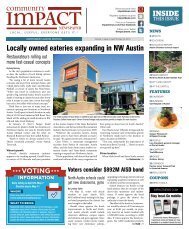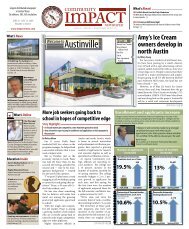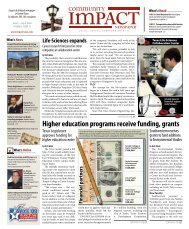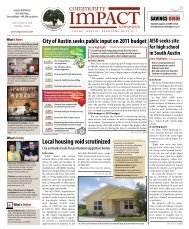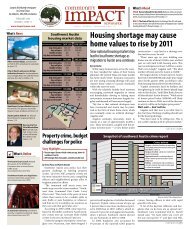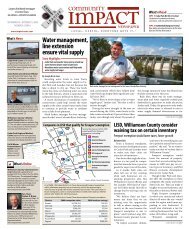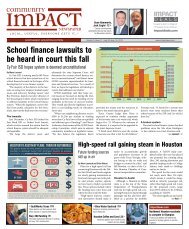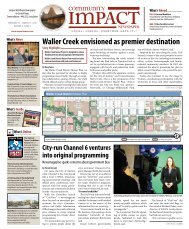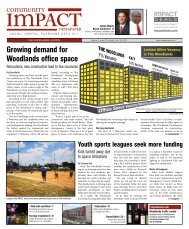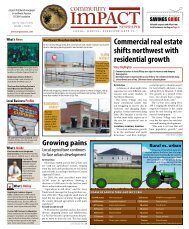July 2010 - Community Impact Newspaper
July 2010 - Community Impact Newspaper
July 2010 - Community Impact Newspaper
You also want an ePaper? Increase the reach of your titles
YUMPU automatically turns print PDFs into web optimized ePapers that Google loves.
Transportation Report | CAMPO’s 2035 Plan includes $27 billion in regional projects<br />
By Jenn Rains and Eric Pulsifer<br />
The CAMPO Transportation Policy<br />
Board voted May 24 to approve the 2035<br />
Plan, with former Sunset Valley Mayor<br />
Jeff Mills and Travis County Commissioner<br />
Karen Huber as the two votes<br />
against it. The plan identifies the top projects<br />
for transportation at the city, county<br />
and regional levels.<br />
“[The Texas Department of Transportation]<br />
sets the priorities if it’s on the<br />
CAMPO 2035 Plan. The construction<br />
dates in there aren’t ones set by CAMPO;<br />
they’re ones set by TxDOT,” Huber said.<br />
“CAMPO is the metropolitan planning<br />
organization, and it seems to me like if<br />
the representatives on the Transportation<br />
Policy Board are going to take the heat<br />
for the roads that don’t get built, then we<br />
ought to have some authority in setting<br />
the priorities for them.”<br />
The new plan came about because federal<br />
law requires metropolitan planning<br />
organizations in attainment to update<br />
long-range plans every five years, former<br />
CAMPO Executive Director Joe Cantalupo,<br />
who rretired in June, said.<br />
CAMPO includes five counties: Williamson,<br />
Travis, Hays, Bastrop and<br />
Caldwell. Bastrop and Caldwell counties<br />
were included in the organization in<br />
February.<br />
Cantalupo said while many people<br />
think a metropolitan planning organization<br />
is just a place to go to receive federal<br />
money, there’s more to CAMPO than<br />
just that.<br />
“What we’re trying to bring more<br />
awareness to is that we’re supposed to<br />
help coordinate the planning process,”<br />
he said.<br />
The new long-range plan for CAMPO<br />
serves two purposes, it “ensures our<br />
region can receive federal funds for transportation<br />
and [functions] as a coordinating<br />
document,” Cantalupo said.<br />
The plan includes a description of each<br />
project along with the location, sponsors<br />
and cost for roads and other transportation<br />
projects.<br />
The latest long-range plan differs from<br />
ones previously and shows a growing<br />
trend: more local spending on state<br />
systems.<br />
“Local spending on transportation<br />
used to go toward local roads, but now,<br />
the federal and state government cannot<br />
give us as much as we need to maintain<br />
systems,” Cantalupo said. “Not only are we<br />
accounting for more local money to be put<br />
into [maintenance and operations] of local<br />
systems, but local money is being spent on<br />
state transportation systems, too.”<br />
Based on the 2035 Plan, about one-third<br />
of the projects—more than $9 billion out<br />
of a total of about $27 billion—of regional<br />
transportation in the next 25 years will be<br />
funded by local governments.<br />
Local governments used to fund city<br />
roads, and state agencies, such as the<br />
Texas Department of Transportation, were<br />
responsible for state and regional roads,<br />
even the portions that fell within the city<br />
limits. However, with budget woes at the<br />
state and federal level, local governments<br />
will be forced to “pick up larger portions of<br />
the bill,” Cantalupo said.<br />
He said the problem with this new<br />
trend is that local governments do not<br />
have the resources needed or the authority<br />
to handle state projects, a problem<br />
that must be addressed if the cities will be<br />
forced to fund the projects.<br />
West Austin<br />
There are practically no transportation<br />
projects in western Travis County<br />
included in CAMPO’s 2035 plan.<br />
Travis County Commissioner Precinct 3<br />
Karen Huber said she believes West Austin<br />
has been neglected.<br />
“I think the CAMPO process is broken—it<br />
ends up being a wish list of every<br />
small locality. Part of the problem with<br />
West Austin is it has grown so fast in<br />
recent years, there was not the need earlier,”<br />
Huber said.<br />
She said CAMPO modeling does not<br />
take into account known growth factors,<br />
such as roads that are platted but not yet<br />
CAMPO 2035 Plan<br />
620<br />
71<br />
Slaughter Ln.<br />
360<br />
2222<br />
Ben White Blvd.<br />
William Cannon Dr.<br />
45<br />
183<br />
MoPac<br />
Lamar Blvd.<br />
S. 1st St.<br />
S. Congress Ave.<br />
Parmer Ln.<br />
I-35<br />
Braker Ln.<br />
7th St.<br />
built in subdivisions off Hwy. 71.<br />
Huber also said West Austin opting out<br />
of Capital Metro early on has kept the area<br />
from being included in its plans, since the<br />
area residents are not paying taxes to the<br />
transportation authority.<br />
SH 45 SW and the Y at Oak Hill<br />
Improvements to SH 45 SW and the Y<br />
at Oak Hill were among projects in the<br />
Airport Blvd.<br />
Riverside Dr.<br />
I-35<br />
Cesar Chavez St.<br />
Addressing traffic in southern Travis County<br />
45<br />
MoPac<br />
45 SW<br />
Bliss<br />
Spillar Rd.<br />
MLK Jr. Blvd.<br />
290<br />
183<br />
Dessau Rd.<br />
290<br />
Brodie Ln.<br />
Ravenscroft Dr.<br />
1626<br />
Frate Barker Rd.<br />
Travis County<br />
Hays County<br />
Slaughter Ln.<br />
130<br />
130<br />
N Map not<br />
to scale<br />
<strong>Community</strong> <strong>Impact</strong> <strong>Newspaper</strong> • impactnews.com <strong>July</strong> <strong>2010</strong> | 19<br />
Manchaca Rd.<br />
N<br />
plan. In the ’90s, TxDOT began rebuilding<br />
Ben White Boulevard as a freeway<br />
starting at I-35 and working west toward<br />
Oak Hill, but work came to a halt in Oak<br />
Hill with opposition from some residents<br />
and elected officials. Now, TxDOT is set to<br />
return to finish the improvements to the<br />
Y at Oak Hill, which will carry a combined<br />
cost of approximately $764 million.<br />
Proposed route of SH 45 SW<br />
Roads proposed to be widened<br />
via pass-through financing<br />
The CAMPO 2035 Plan calls for SH 45 SW to be<br />
built, most likely as a $93 million four-lane toll<br />
road with an opening date of 2022. Though<br />
the road would end at FM 1626, Hays County is<br />
exploring extending the road to I-35 as it was<br />
originally envisioned when planned as part of a<br />
loop around Austin in the 1980s.<br />
In the interim before the road can be built,<br />
Travis County is looking at short-term<br />
improvements such as widening Manchaca<br />
Road and FM 1626 and making improvements<br />
to Frate Barker Road.<br />
Sample projects in Austin<br />
from CAMPO 2035 Plan<br />
Many of Austin’s projects included in<br />
the CAMPO 2035 Plan focus on arterial<br />
roadways—major roads connecting the<br />
city, HOV lanes and public transportation<br />
services.<br />
Ben White Boulevard at I-35 is a TxDOTsponsored<br />
project that will see the<br />
construction of four direct connects at the<br />
interchange. The direct connects will allow<br />
traffic to flow smoothly from one roadway<br />
to the next without using access roads or<br />
having to exit. The project is scheduled<br />
to start in <strong>2010</strong> and is expected to be<br />
complete by 2012.<br />
TxDOT and the Central Texas Regional<br />
Mobility Authority are sponsoring a project<br />
in two phases to create managed lanes<br />
on northbound and southbound Loop 1,<br />
or MoPac, from Parmer Lane to Slaughter<br />
Lane. Unlike HOV lanes, managed lanes<br />
would restrict the speed on the road and<br />
charge a toll, though the charge would<br />
depend on the amount of traffic in the<br />
lanes. Phase one from Parmer Lane to<br />
Cesar Chavez is due to begin in 2013 and be<br />
completed by 2015. Phase two, from Cesar<br />
Chavez Street to Slaughter Lane, will start in<br />
2015 and be completed by 2017.<br />
A project to create bus-only or highoccupancy<br />
lanes on North Lamar Boulevard<br />
from the Tech Ridge Park and Ride, 900<br />
Center Ridge Drive, to downtown Austin,<br />
is projected to begin in 2025 and will take<br />
about 10 years to complete. The project is<br />
unsponsored; and funding has not been<br />
allocated but could come from local, state<br />
or federal resources.<br />
An urban rail extension in the south part<br />
of the city is being sponsored by the City<br />
of Austin, is projected to begin in 2020<br />
and will take about five years to finish.<br />
The extension would involve expanding<br />
the streetcar from downtown Austin<br />
along Riverside Drive to Austin-Bergstrom<br />
International Airport.



